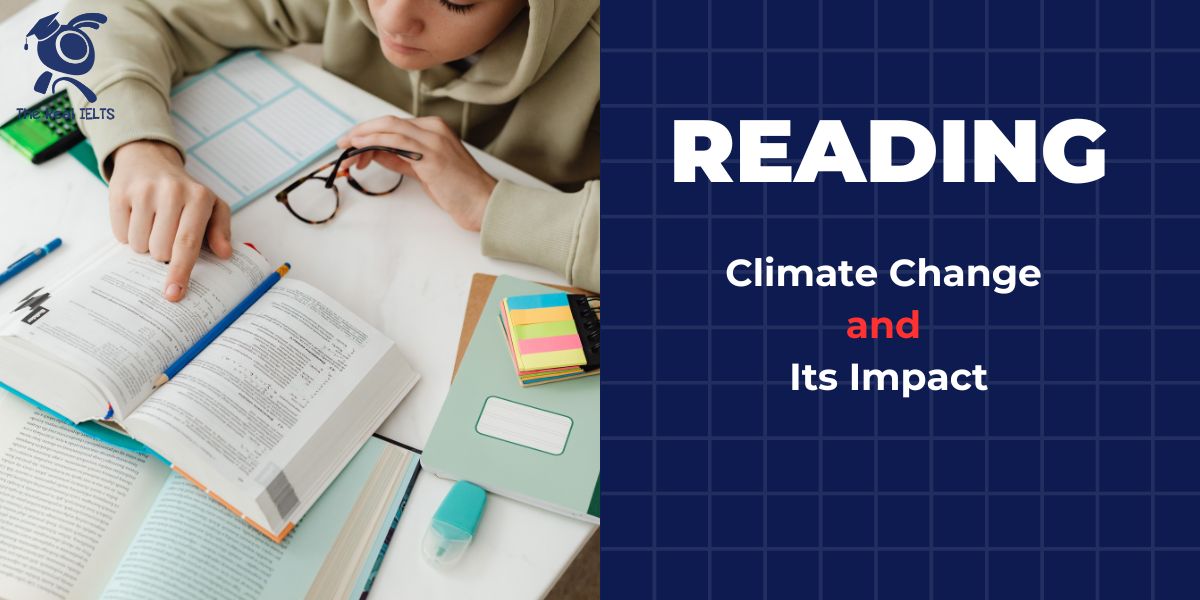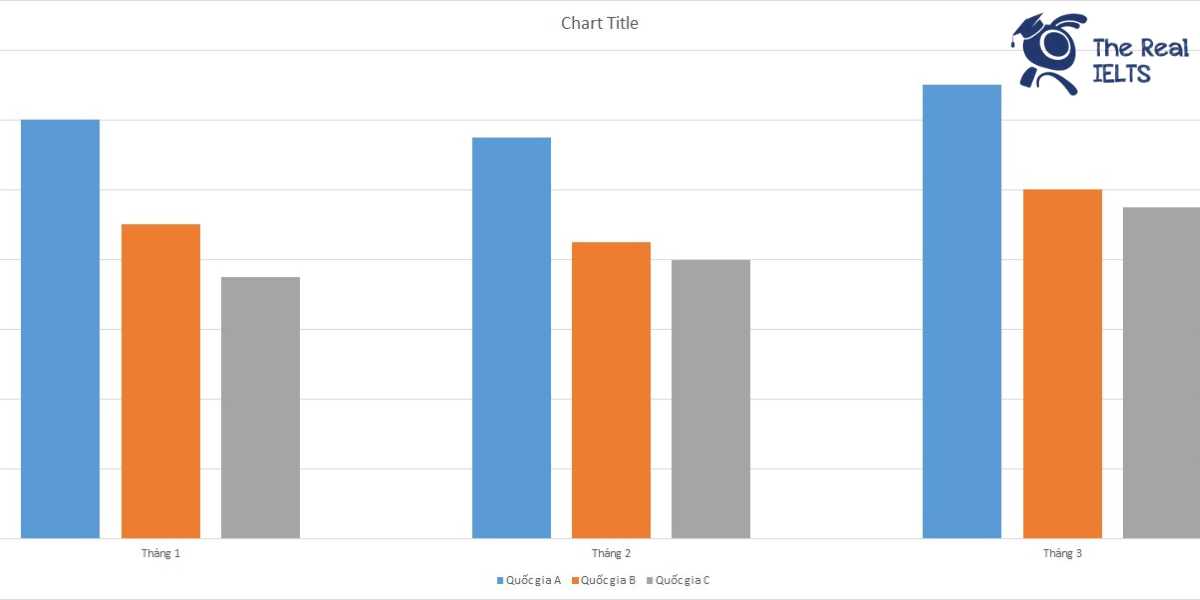Chủ đề Food and Diet thuộc chuỗi bài 20 chủ đề luyện Reading và từ vựng để thi IELTS thống kê lại 100 từ vựng cần thiết trong chủ đề này để sử dụng trong các bài thi.
100 từ vựng chủ đề FOOD AND DIET
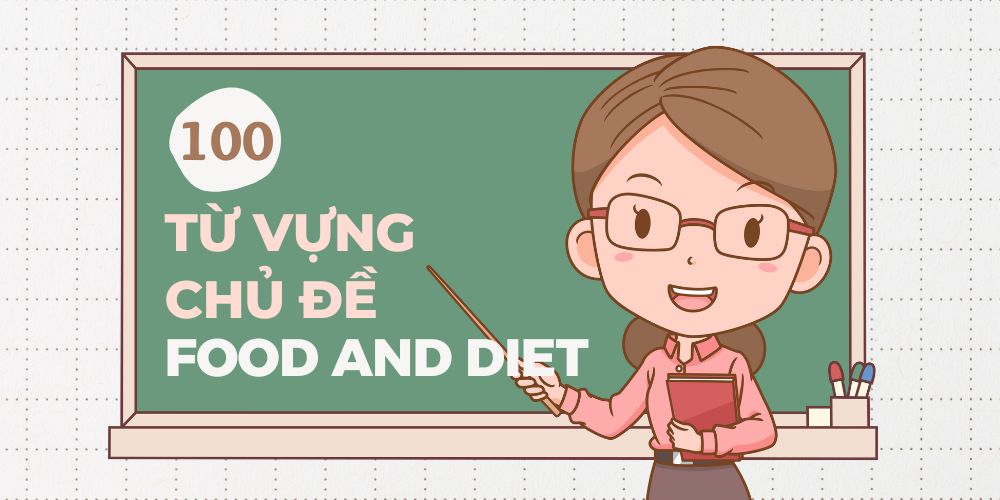

| Nourishment | Dinh dưỡng | The nourishment provided by a well-balanced diet ensures optimal health. | Sự dinh dưỡng được cung cấp bởi một chế độ dinh dưỡng cân đối đảm bảo sức khỏe tối ưu. |
| Culinary | Ẩm thực | Culinary enthusiasts often experiment with diverse cooking techniques. | Những người đam mê ẩm thực thường thử nghiệm với các kỹ thuật nấu ăn đa dạng. |
| Appetizer | Món khai vị | The appetizer whetted our appetite for the delightful meal to come. | Món khai vị kích thích khẩu vị cho bữa ăn ngon sắp đến. |
| Nutrient | Chất dinh dưỡng | Nutrients like vitamins and minerals are essential for bodily functions. | Chất dinh dưỡng như vitamin và khoáng chất quan trọng cho các chức năng cơ thể. |
| Organic | Hữu cơ | Choosing organic produce supports sustainable and chemical-free farming practices. | Lựa chọn sản phẩm hữu cơ hỗ trợ các phương pháp canh tác bền vững và không sử dụng hóa chất. |
| Digest | Tiêu hóa | It takes time to digest complex foods compared to simpler ones. | Cần thời gian để tiêu hóa thức ăn phức tạp so với thức ăn đơn giản. |
| Balanced diet | Chế độ ăn cân đối | Maintaining a balanced diet is crucial for overall well-being. | Duy trì một chế độ dinh dưỡng cân đối là quan trọng cho sức khỏe tổng thể. |
| Palate | Vị giác | The chef’s sophisticated palate can discern subtle flavors in any dish. | Đầu bếp có khẩu vị tinh tế có thể nhận biết mùi vị tinh tế trong mọi món ăn. |
| Cuisine | Ẩm thực | Each region boasts its own unique cuisine, reflecting local culture. | Mỗi khu vực đều tự hào với ẩm thực độc đáo, phản ánh văn hóa địa phương. |
| Savory | Mặn | The savory aroma of the dish filled the kitchen, making everyone hungry. | Hương thơm ngon của món ăn lan tỏa trong nhà bếp, làm cho mọi người đói. |
| Sweet tooth | Sở thích ăn ngọt | Those with a sweet tooth often indulge in desserts and sugary treats. | Những người thích ngọt thường tận hưởng các món tráng miệng và đồ ngọt. |
| Superfood | Siêu thực phẩm | Superfoods like quinoa and kale are packed with nutritional benefits. | Siêu thực phẩm như quinoa và cải xanh đều chứa đựng nhiều lợi ích dinh dưỡng. |
| Gluten-free | Không chứa gluten | A gluten-free diet is essential for individuals with gluten sensitivity. | Chế độ không gluten là cần thiết đối với những người nhạy cảm với gluten. |
| Vegan | Ăn chay | Vegan diets exclude all animal products, including meat and dairy. | Chế độ ăn chay loại bỏ tất cả các sản phẩm động vật, bao gồm cả thịt và sữa. |
| Vegetarian | Chay | Vegetarians avoid meat but may still consume dairy and eggs. | Người ăn chay tránh thịt nhưng có thể tiêu thụ sữa và trứng. |
| Protein | Protein | Protein is essential for muscle development and overall body function. | Protein quan trọng cho sự phát triển cơ bắp và chức năng tổng thể của cơ thể. |
| Carbohydrate | Carbohydrate | Carbohydrates provide a primary source of energy for the body. | Carbohydrate cung cấp nguồn năng lượng chính cho cơ thể. |
| Fiber | Chất xơ | A diet rich in fiber promotes digestive health and prevents constipation. | Chế độ giàu chất xơ khuyến khích sức khỏe tiêu hóa và ngăn chặn táo bón. |
| Minerals | Khoáng chất | Essential minerals like calcium and iron contribute to overall well-being. | Khoáng chất cần thiết như canxi và sắt đóng góp vào sức khỏe tổng thể. |
| Vitamins | Vitamin | Vitamins, such as A, C, and D, are vital for various bodily functions. | Vitamin như A, C và D là quan trọng cho nhiều chức năng cơ thể. |
| Calorie | Lượng calo | Monitoring calorie intake is crucial for weight management. | Giám sát lượng calo tiêu thụ là quan trọng để quản lý cân nặng. |
| Gourmet | Nghệ thuật ẩm thực | Gourmet chefs often use high-quality ingredients to create exquisite dishes. | Đầu bếp thượng lưu thường sử dụng nguyên liệu chất lượng cao để tạo ra những món ăn tinh tế. |
| Saturated fat | Chất béo bão hòa | Saturated fat, found in butter and cheese, should be consumed in moderation. | Chất béo no, có trong bơ và phô mai, nên được tiêu thụ một cách có chừng mực. |
| Unsaturated fat | Chất béo không bão hòa | Choosing unsaturated fats like olive oil supports heart health. | Chọn chất béo không no như dầu olive để hỗ trợ sức khỏe tim mạch. |
| Hydration | Sự cân bằng nước | Staying well-hydrated is essential for overall bodily functions. | Giữ nước cũng quan trọng để đảm bảo chức năng cơ thể hoạt động đúng cách. |
| Refreshment | Đồ uống giải khát | A refreshing beverage is the perfect way to quench your thirst. | Một đồ uống sảng khoái là cách hoàn hảo để dập tắt khát của bạn. |
| Junk food | Thức ăn nhanh | Consuming too much junk food can negatively impact your health. | Tiêu thụ quá nhiều thực phẩm rác có thể ảnh hưởng tiêu cực đến sức khỏe của bạn. |
| Processed food | Thức ăn chế biến | Processed foods often contain additives and preservatives. | Thực phẩm chế biến thường chứa phụ gia và chất bảo quản. |
| Diabetic | Người tiểu đường | Diabetics need to carefully manage their blood sugar levels through diet. | Người tiểu đường cần quản lý cẩn thận mức đường huyết của họ thông qua chế độ ăn uống. |
| Low-fat | Ăn ít chất béo | Low-fat diets focus on reducing the intake of fatty foods. | Chế độ ăn ít chất béo tập trung vào giảm lượng thực phẩm chứa chất béo. |
| High-fiber | Ăn nhiều chất xơ | High-fiber foods promote a feeling of fullness and aid in digestion. | Thực phẩm giàu chất xơ thúc đẩy cảm giác no và hỗ trợ quá trình tiêu hóa. |
| Nut allergy | Dị ứng thức ăn | Nut allergies can lead to severe reactions and require careful avoidance. | Duy trì sự cảnh báo về dị ứng gluten có thể gây ra vấn đề tiêu hóa. |
| Fresh produce | Rau quả tươi | Fresh produce, such as fruits and vegetables, is essential for a healthy diet. | Sản phẩm tươi mới, như trái cây và rau, là quan trọng cho một chế độ dinh dưỡng lành mạnh. |
| Dairy | Sữa | Dairy products are a good source of calcium and vitamin D. | Sản phẩm sữa cung cấp nguồn canxi và vitamin D tốt cho sức khỏe xương. |
| Grains | Ngũ cốc | Grains, like rice and wheat, are staple foods in many cultures. | Ngũ cốc, như cơm và lúa mạch, là thực phẩm cơ bản trong nhiều văn hóa. |
| Omega-3 fatty acids | Axit béo omega-3 | Omega-3 fatty acids, found in fish, support heart and brain health. | Axit béo omega-3, có trong cá, hỗ trợ sức khỏe tim mạch và não bộ. |
| Antioxidants | Chất chống ô nhiễm | Antioxidants in fruits and vegetables help protect cells from damage. | Chất chống ô nhiễm trong trái cây và rau giúp bảo vệ tế bào khỏi tổn thương. |
| Portion control | Sữa probiotics | Portion control is essential for maintaining a healthy weight. | Kiểm soát lượng thức ăn ăn mỗi lần quan trọng để duy trì cân nặng khỏe mạnh. |
| Gluten sensitivity | Dinh dưỡng chức năng | Gluten sensitivity can cause digestive issues in some individuals. | Những người nhạy cảm với gluten cần tránh những thực phẩm chứa gluten. |
| Food pyramid | Cân nặng cơ thể | The food pyramid illustrates the recommended daily intake of various food groups. | Pyramide thức ăn biểu đồ hóa lượng thức ăn hợp lý hàng ngày. |
| Food group | Nhóm thực phẩm | Categorizing foods into groups helps create a balanced diet plan. | Phân loại thức ăn thành các nhóm giúp tạo ra một kế hoạch dinh dưỡng cân đối. |
| Cravings | Sự thèm ăn | Cravings for sweets or salty snacks can be hard to resist. | Nỗi khao khát đối với đồ ngọt hoặc đồ mặn có thể khó chịu. |
| Binge eating | Ăn quá mức | Binge eating can lead to feelings of guilt and negatively impact health. | Ăn quá mức có thể dẫn đến cảm giác tội lỗi và ảnh hưởng tiêu cực đến sức khỏe. |
| Snacking | Ăn vặt | Snacking on healthy options between meals can boost energy levels. | Ăn vặt giữa các bữa ăn có thể tăng cường năng lượng. |
| Dehydration | Mất nước | Dehydration can cause fatigue, dizziness, and other health issues. | Mất nước có thể gây ra mệt mỏi, chói lọi và các vấn đề sức khỏe khác. |
| Fasting | Giữ chế độ ăn | Fasting for religious or health reasons has been practiced for centuries. | ăn chay vì lý do tôn giáo hoặc sức khỏe đã được thực hiện từ thời cổ đại. |
| Detox | Thải độc | Detox diets aim to eliminate toxins from the body through specific foods. | Chế độ detox nhằm loại bỏ độc tố từ cơ thể thông qua thực phẩm cụ thể. |
| Caloric intake | Tiêu thụ calo | Monitoring caloric intake is essential for weight management. | Giám sát lượng calo tiêu thụ quan trọng để quản lý cân nặng. |
| Meal prep | Chuẩn bị bữa ăn | Meal prep can save time and promote healthier eating habits. | Chuẩn bị bữa ăn trước có thể tiết kiệm thời gian và thúc đẩy thói quen ăn uống lành mạnh. |
| Foodborne illness | Bệnh từ thực phẩm | Foodborne illness can result from consuming contaminated or undercooked food. | Bệnh do thực phẩm nhiễm khuẩn có thể xuất phát từ việc tiêu thụ thực phẩm bị ô nhiễm hoặc chưa nấu chín. |
| Digestion | Tiêu hóa | Digestion begins in the mouth and continues in the stomach and intestines. | Tiêu hóa bắt đầu từ miệng và tiếp tục ở dạ dày và ruột. |
| Metabolism | Sự trao đổi chất | Metabolism refers to the body’s process of converting food into energy. | Sự trao đổi chất đề cập đến quá trình cơ thể chuyển đổi thức ăn thành năng lượng. |
| Caffeine | Caffeine | Caffeine, found in coffee and tea, can provide a temporary energy boost. | Caffeine, có trong cà phê và trà, có thể mang lại sự hứng khởi tạm thời. |
| Sugary beverages | Đồ uống có đường | Sugary beverages contribute to excess calorie intake and may impact health. | Đồ uống có đường đóng góp vào lượng calo thặng dư và có thể ảnh hưởng đến sức khỏe. |
| Water retention | Giữ nước | Water retention can lead to temporary weight gain and bloating. | Giữ nước có thể dẫn đến tăng cân tạm thời và sưng. |
| Satiety | Sự no | Satiety is the feeling of fullness and satisfaction after a meal. | Sự no là cảm giác no và hài lòng sau một bữa ăn. |
| BMI (Body Mass Index) | Chỉ số cơ thể khối lượng | BMI is a numerical measure of body fat based on height and weight. | BMI là một chỉ số số đo cơ thể chất béo dựa trên chiều cao và cân nặng. |
| Dietary fiber | Chất xơ dinh dưỡng | Dietary fiber aids in digestion and helps prevent constipation. | Chất xơ dinh dưỡng giúp quá trình tiêu hóa và ngăn chặn táo bón. |
| Empty calories | Calo trống rỗng | Empty calories provide energy but lack essential nutrients. | Calo rỗng cung cấp năng lượng nhưng thiếu các chất dinh dưỡng cần thiết. |
| Nutritional value | Giá trị dinh dưỡng | Nutritional value varies among different foods and food groups. | Giá trị dinh dưỡng biến đổi giữa các thực phẩm và các nhóm thực phẩm khác nhau. |
| Probiotics | Probiotics | Probiotics in yogurt support a healthy balance of gut bacteria. | Vi sinh vật có lợi trong sữa chua hỗ trợ sự cân bằng của vi khuẩn ruột. |
| Nutraceuticals | Dinh dưỡng chức năng | Nutraceuticals are food products with health benefits beyond basic nutrition. | Nutraceuticals là các sản phẩm thực phẩm có lợi ích sức khỏe vượt ra ngoài dinh dưỡng cơ bản. |
| Food label | Nhãn thực phẩm | Reading the food label helps consumers make informed choices. | Đọc nhãn thực phẩm giúp người tiêu dùng đưa ra quyết định có thông tin. |
| Whole foods | Thực phẩm nguyên chất | Whole foods, like fruits and vegetables, are minimally processed and nutrient-dense. | Thực phẩm nguyên liệu như trái cây và rau ít được xử lý và giàu chất dinh dưỡng. |
| Artificial sweeteners | Chất tạo ngọt nhân tạo | Artificial sweeteners provide sweetness without the calories of sugar. | Đường nhân tạo mang lại hương vị ngọt mà không có calo của đường. |
| Free radicals | Radicals tự do | Free radicals can damage cells and are neutralized by antioxidants. | Radicals tự do có thể làm tổn thương tế bào và được chống lại bởi chất chống ô nhiễm. |
| Sustainably sourced | Nguồn gốc bền vững | Choosing sustainably sourced products helps protect the environment. | Chọn sản phẩm nguồn gốc bền vững giúp bảo vệ môi trường. |
| Fair trade | Thương mại công bằng | Fair trade products ensure fair compensation for farmers and workers. | Sản phẩm công bằng đảm bảo sự bù đắp công bằng cho nông dân và người lao động. |
| Pesticide-free | Không chứa thuốc trừ sâu | Opting for pesticide-free produce reduces exposure to harmful chemicals. | Chọn sản phẩm không chứa thuốc trừ sâu giảm tiếp xúc với hóa chất độc hại. |
| Non-GMO | Không biến đổi gen | Non-GMO foods are free from genetically modified organisms. | Thực phẩm không chứa GMO không có chất gen biến đổi. |
| Locavore | Người ăn địa phương | Locavores prioritize consuming locally sourced and produced foods. | Người ăn địa phương ưu tiên tiêu thụ thực phẩm được sản xuất và cung cấp địa phương. |
| Mindful eating | Ăn uống tỉnh thức | Mindful eating involves savoring each bite and paying attention to hunger cues. | Ăn một cách chậm rãi liên quan đến việc thưởng thức từng miếng và chú ý đến dấu hiệu đói. |
| Emotional eating | Ăn theo cảm xúc | Emotional eating can be a response to stress, boredom, or other emotions. | Ăn do tình cảm có thể là phản ứng với stress, buồn chán hoặc cảm xúc khác. |
| Nutritional supplements | Bổ sung dinh dưỡng | Nutritional supplements may be necessary to address specific dietary deficiencies. | Bổ sung dinh dưỡng có thể cần thiết để giải quyết các thiếu hụt dinh dưỡng cụ thể. |
| Alkaline diet | Chế độ kiềm | An alkaline diet emphasizes foods that help maintain a slightly alkaline pH. | Chế độ kiêng khem kiểm soát lượng thức ăn axit trong cơ thể. |
| Raw food diet | Chế độ thực phẩm sống | Raw food diets consist of uncooked and unprocessed foods. | Chế độ ăn sống bao gồm thực phẩm chưa được nấu chín và không qua xử lý. |
| Mediterranean diet | Chế độ ăn Địa Trung Hải | The Mediterranean diet emphasizes fruits, vegetables, and olive oil. | Chế độ ăn Địa Trung Hải tập trung vào trái cây, rau và dầu olive. |
| Atkins diet | Chế độ Atkins | The Atkins diet restricts carbohydrates for weight loss. | Chế độ ăn Atkins hạn chế carbohydrate để giảm cân. |
| Ketogenic diet | Chế độ ăn ít carbohydrate | The ketogenic diet is high in fat, low in carbs, and promotes ketosis. | Chế độ ăn ketogenic giàu chất béo, thấp carbohydrate và khuyến khích tình trạng ketosis. |
| Paleo diet | Chế độ ăn Paleo | The paleo diet focuses on foods believed to have been eaten by early humans. | Chế độ ăn paleo tập trung vào thực phẩm tin rằng người tiền sử đã tiêu thụ. |
| Flexitarian | Người ăn đa dạng | Flexitarians primarily follow a vegetarian diet but occasionally eat meat. | Người theo chế độ ăn linh hoạt chủ yếu ăn chay nhưng đôi khi ăn thịt. |
| Intermittent fasting | Giảm cân nhanh | Intermittent fasting involves cycles of eating and fasting for health benefits. | Ứng dụng ăn đều và nhịp nhàng liên quan đến việc thay phiên giữa việc ăn và nhịn để đạt được lợi ích cho sức khỏe. |
| Nutrient density | Chế độ ăn đói | Nutrient density measures the amount of nutrients in a given food. | Mật độ dinh dưỡng đo lường lượng chất dinh dưỡng trong một loại thực phẩm cụ thể. |
| Empty calories | Mật độ dinh dưỡng | Empty calories provide energy without significant nutritional value. | Calo trống rỗng cung cấp năng lượng mà không có giá trị dinh dưỡng đáng kể. |
| Blood sugar levels | Calo trống rỗng | Blood sugar levels need to be monitored, especially for diabetics. | Cần theo dõi mức đường huyết, đặc biệt là đối với người bị tiểu đường. |
| Glycemic index | Mức đường huyết | The glycemic index measures how quickly a food raises blood sugar levels. | Chỉ số đường huyết đo lường tốc độ mà thức ăn tăng mức đường huyết. |
| Bariatric surgery | Chỉ số đường huyết | Bariatric surgery is a medical procedure to help with weight loss. | Phẫu thuật giảm cân là một thủ thuật y tế giúp giảm cân. |
| Food addiction | Phẫu thuật giảm cân | Food addiction can have physical and psychological components. | Nghiện thức ăn có thể có các yếu tố về mặt vật lý và tâm lý. |
| Anorexia | Nghiện thức ăn | Anorexia nervosa is an eating disorder characterized by self-imposed starvation. | Rối loạn ăn kiêng là một rối loạn dinh dưỡng được đặc trưng bởi việc tự áp đặt chế độ ăn kiêng. |
| Bulimia | Rối loạn ăn uống | Bulimia nervosa involves binge-eating followed by purging behaviors. | Bulimia là việc ăn quá mức theo sau bởi các hành vi làm sạch cơ thể. |
| Nutrigenomics | Rối loạn ăn | Nutrigenomics explores the interaction between genes and nutrition. | Nutrigenomics khám phá mối quan hệ giữa gen và dinh dưỡng. |
| Sustainable farming | Dinh dưỡng gen | Sustainable farming practices prioritize environmental conservation. | Phương pháp nông nghiệp bền vững ưu tiên bảo tồn môi trường. |
| Carbon footprint | Nông nghiệp bền vững | Carbon footprint measures the environmental impact of food production. | Dấu chân carbon đo lường tác động môi trường của sản xuất thực phẩm. |
| Locally sourced | Dấu chân carbon | Locally sourced products support nearby farmers and reduce transportation emissions. | Sản phẩm được cung cấp địa phương hỗ trợ nông dân địa phương và giảm lượng khí thải từ vận chuyển. |
| Food insecurity | Nguồn gốc địa phương | Food insecurity refers to a lack of consistent access to nutritious food. | Bất an về thực phẩm đề cập đến việc thiếu một cách tiếp cận đều đặn đến thực phẩm dinh dưỡng. |
| Malnutrition | An ninh thực phẩm | Malnutrition can result from inadequate or imbalanced dietary intake. | Suy dinh dưỡng có thể xuất phát từ lượng chất dinh dưỡng không đủ hoặc không cân đối. |
| Food preservation | Sự dinh dưỡng yếu kém | Food preservation methods include canning, freezing, and drying. | Phương pháp bảo quản thực phẩm bao gồm đóng hộp, đóng lạnh và làm khô. |
| Fermentation | Bảo quản thực phẩm | Fermentation is a traditional method of preserving and enhancing food. | Lên men là một phương pháp truyền thống để bảo quản và cải thiện thực phẩm. |
| Hydroponics | Lên men | Hydroponics is a soil-less method of growing plants with nutrient-rich water. | Thủy canh là một phương pháp trồng cây mà không cần đất, sử dụng nước giàu chất dinh dưỡng. |
| Portion size | Thủy canh | Portion size influences calorie intake and overall diet quality. | Kích thước phần ảnh hưởng đến lượng calo tiêu thụ và chất lượng chung của chế độ dinh dưỡng. |
Bài tập chủ đề FOOD and DIET
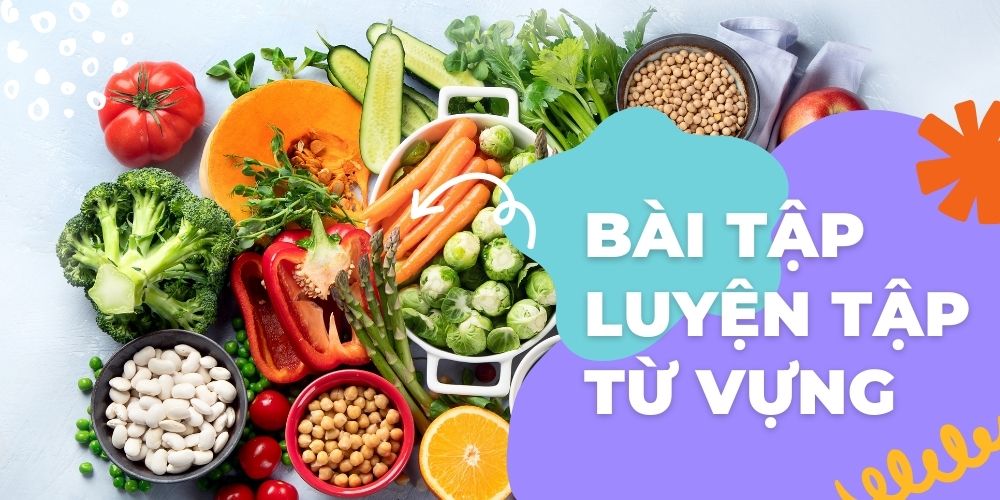

- Choose a __________ that is rich in essential __________ for a healthy lifestyle.
- The __________ arts involve the preparation and presentation of food.
- An __________ is a small dish served before the main course to stimulate the appetite.
- It’s important to maintain a __________ diet to ensure you get all the necessary nutrients.
- Your __________ is your sense of taste and the ability to discern flavors.
- Some people follow an __________ lifestyle, avoiding animal products entirely.
- Including __________ in your diet is essential for muscle repair and growth.
- Fruits and vegetables are examples of __________ foods that are grown without synthetic chemicals.
- The human body needs enzymes to help __________ food properly.
- A __________ diet incorporates a variety of foods to provide a broad spectrum of nutrients.
- Culinary enthusiasts often experiment with __________ flavors and ingredients.
- If you have a __________, you might crave sweet foods frequently.
- Quinoa is considered a __________ due to its high nutritional value.
- People with celiac disease need to follow a __________ diet to avoid gluten.
- A __________ diet excludes all animal products, including meat, dairy, and eggs.
- __________ is an essential macronutrient that supports muscle development.
- Bread, rice, and pasta are sources of __________, a primary energy source.
- Consuming sufficient __________ is crucial for maintaining a healthy digestive system.
- Fruits and vegetables provide essential vitamins and __________ for the body.
- Monitoring your __________ intake is important for weight management.
- Exploring different __________ is a great way to appreciate diverse culinary traditions.
- A __________ fat diet can help reduce the risk of heart disease.
- Olive oil is an example of a healthy __________ fat.
- Drinking enough water is crucial for proper __________ and overall health.
- Tea and coffee are popular __________ for many people.
- __________ food items are often high in sugar, salt, and unhealthy fats.
- Many health experts recommend avoiding __________ foods for better nutrition.
- __________ foods are those that have undergone significant processing.
- Individuals with diabetes must carefully manage their __________ intake.
- Opting for a __________ diet helps reduce environmental impact.
- A __________ lifestyle excludes all animal products, including meat, dairy, and honey.
- Consuming sufficient __________ is important for muscle function and overall health.
- A diet rich in __________ can help lower the risk of chronic diseases.
- __________ is a common protein source found in meat, poultry, and fish.
- Nutritional labels provide information about the __________ of a food product.
- Choosing __________ options is crucial for maintaining a well-balanced diet.
- Including a variety of __________ in your diet ensures a broad range of nutrients.
- __________ intolerance can cause digestive discomfort when consuming certain foods.
- A __________ diet focuses on plant-based foods and limits or excludes animal products.
- Consuming sufficient __________ is crucial for bone health.
- The __________ guide helps individuals make informed choices about their diet.
- Grouping foods based on their nutritional content creates a balanced __________.
- Listening to your __________ can help you distinguish between hunger and cravings.
- __________ eating involves paying attention to the taste, texture, and smell of food.
- Emotional __________ can lead to unhealthy eating habits and weight gain.
- Nutritional __________ are pills or powders that supplement the diet.
- Some foods are considered __________, offering health benefits beyond basic nutrition.
- Reading the __________ on food packaging helps make informed choices.
- Consuming __________ foods provides essential nutrients without added sugars or fats.
- __________ density measures the nutritional value of a food relative to its calorie content.
- Consuming too many __________ can contribute to weight gain and health issues.
- The __________ diet emphasizes the consumption of raw, unprocessed foods.
- __________ is a natural process that breaks down food in the digestive system.
- Some people follow an __________ diet, avoiding grains containing gluten.
- Maintaining proper __________ levels is crucial for overall health.
- __________ is the satisfaction and fullness experienced after eating a meal.
- The __________ is a tool used to assess whether a person’s weight is healthy for their height.
- Including __________ foods in your diet promotes a healthy cardiovascular system.
- Consuming __________ calories without nutritional value can lead to weight issues.
- __________ labeling provides information about a food product’s nutrients.
- __________ are live microorganisms that support a healthy digestive system.
- __________ are foods with health benefits that go beyond basic nutrition.
- Paying attention to __________ can help make sustainable and ethical food choices.
- __________ farming aims to minimize environmental impact and promote biodiversity.
- Choosing __________ options supports local farmers and reduces transportation emissions.
- __________ foods are produced without genetic modification.
- A __________ focuses on consuming locally produced food.
- __________ eating involves being fully present and attentive during meals.
- __________ eating addresses emotional triggers for unhealthy food choices.
- __________ surgery is a medical procedure for weight management.
- __________ is an eating disorder characterized by self-imposed starvation.
- __________ is an eating disorder characterized by binge eating followed by purging.
- __________ explores the interaction between genetics and nutrition.
- __________ farming methods aim to minimize the use of synthetic pesticides.
- __________ farming grows crops without soil, using nutrient-rich water instead.
- Paying attention to __________ sizes helps control calorie intake.
- __________ size influences the amount of energy consumed during a meal.
- The __________ diet emphasizes a balance between plant-based and animal-based foods.
- The __________ diet restricts carbohydrate intake to promote weight loss.
- The __________ diet focuses on whole foods consumed during the Paleolithic era.
- A __________ includes both plant-based and occasional meat-based meals.
- __________ fasting involves alternating periods of eating and fasting.
- Consuming a variety of __________ foods ensures a broad range of nutrients.
- __________ calories provide little to no nutritional value.
- Monitoring __________ levels is important for managing blood sugar.
- The __________ index measures the impact of food on blood sugar levels.
- __________ surgery is a medical option for extreme weight loss.
- __________ addiction involves a compulsive relationship with food.
- __________ is an eating disorder characterized by extreme weight loss.
- __________ is an eating disorder characterized by binge eating without purging.
- __________ explores the relationship between genes and nutrition.
- __________ farming practices aim to minimize harm to the environment.
- __________ farming reduces the carbon footprint associated with food production.
- __________ farming involves growing crops without synthetic pesticides.
- Choosing __________ options supports local farmers and reduces environmental impact.
- __________ is a global issue where people lack access to sufficient, nutritious food.
- __________ can lead to malnutrition and other health issues.
- __________ methods like canning and freezing help extend the shelf life of food.
- __________ is a traditional method of preserving food through bacterial fermentation.
- __________ is a method of growing plants without soil, using nutrient-rich water.
Đáp án
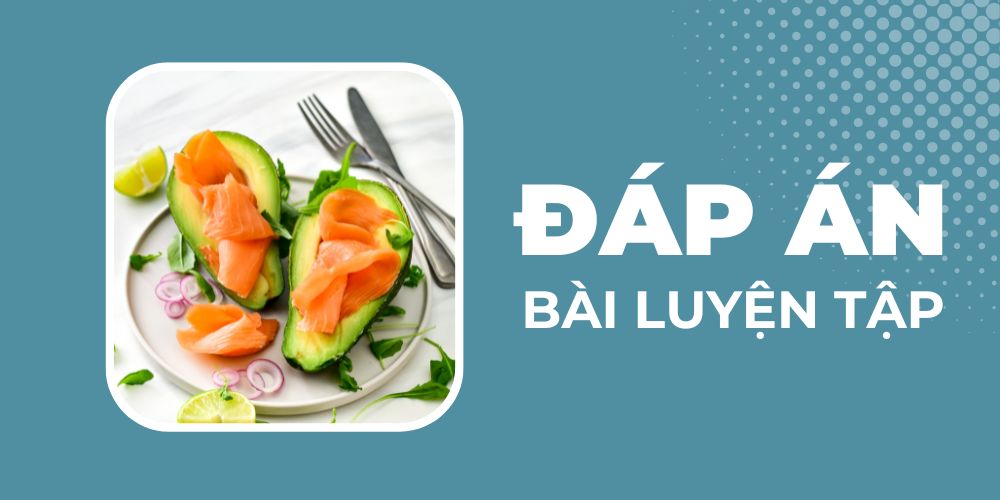

- diet, nutrients
- culinary
- appetizer
- balanced
- palate
- vegan
- protein
- organic
- digest
- varied
- savory
- sweet tooth
- superfood
- gluten-free
- vegetarian
- protein
- carbohydrate
- fiber
- minerals
- vitamins
- calorie
- gourmet
- saturated
- unsaturated
- hydration
- refreshment
- junk
- processed
- diabetic
- low-fat
- high-fiber
- nut allergy
- fresh
- dairy
- grains
- omega-3
- antioxidants
- portion control
- gluten sensitivity
- food pyramid
- food group
- cravings
- binge eating
- snacking
- dehydration
- fasting
- detox
- caloric
- meal prep
- foodborne illness
- digestion
- metabolism
- caffeine
- sugary beverages
- water retention
- satiety
- BMI
- dietary fiber
- empty calories
- nutritional value
- probiotics
- nutraceuticals
- food label
- whole foods
- artificial sweeteners
- free radicals
- sustainably sourced
- fair trade
- pesticide-free
- non-GMO
- locavore
- mindful eating
- emotional eating
- nutritional supplements
- alkaline diet
- raw food diet
- Mediterranean diet
- Atkins diet
- ketogenic diet
- paleo diet
- flexitarian
- intermittent fasting
- nutrient density
- empty calories
- blood sugar levels
- glycemic index
- bariatric surgery
- food addiction
- anorexia
- bulimia
- nutrigenomics
- sustainable farming
- carbon footprint
- locally sourced
- food insecurity
- malnutrition
- food preservation
- fermentation
- hydroponics
- portion size




